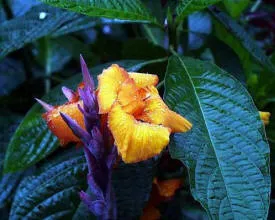The Jungles of Costa Rica

Just the word jungle (selva) brings a lot of images to the average reader. It might be a Rudyard Kipling thing, Tarzan, or Jungle Jim, but everyone has an idea of what is a jungle. Few people know the jungles of Costa Rica than contributor Jack Ewing, the man behind Hacienda Barú, a national wildlife preserve covering 330 hectares (815 acres) on Costa Rica’s Southern Pacific Coast near Dominical.
Hacienda Barú consists of many habitats; wetlands, secondary forest in the lowlands and primary forest on the highland coastal ridge… and of course, the jungle.
The is also nothing more romantic than taking a stroll on the beach, or anywhere, under a full Costa Rica moon! Here, Jack Ewing gives us some wonderful detail about some facts and legends about our Costa Rica moon!
MOON LORE
Method, Magic or Madness?
by Jack Ewing
This is Chapter 22 in his book Monkeys Are Made of Chocolate: Exotic and Unseen Costa Rica
© Jack Ewing Used with permission
Few aspects of human experience have stimulated the imagination more than earth’s satellite, the moon. We find it woven into the very fabric of our culture, appearing in everything from religion to nursery rhymes. Let’s look at a few examples. Religion: Have you ever wondered what determines on which Sunday Easter will be celebrated, or if it is merely up to the whims calendar makers? Actually it’s determined by the moon. Easter is defined as the first Sunday after the first full moon that appears on or after the spring equinox, March 21. Fairy tales and nursery rhymes: There is the “Man in the Moon” and “The Cow Jumped Over the Moon.” Popular songs: We have “Moon River” and “Blue Moon.” Folklore: The Harvest Moon is the first full moon after the fall equinox, so named because the full moon rises shortly after the sun sets, thus allowing farmers light by which they can continue working and bring in their crops. Romance: The full moon is said to bring out feelings of love and stimulate pent up passions. Mythology: “Luna,” the mythic Roman moon goddess was known as “Selene” by the Greeks. Superstition: Vampires are said to fear the full moon while witches love it, flying on their broomsticks silhouetted on the face of the full moon. Also the full moon is supposed to drive people crazy as evidenced by the word lunatic, derived from lunar.
Our language is full of references to the moon. My dictionary lists fifteen words that begin with moon and thirteen that begin with luna, an alternate word for moon. My thesaurus lists eight synonyms for moon that are nouns and fourteen verbs. With the advent space flight and lunar landings several new terms such as moon craft, moonscape, moon quake and lunar module were introduced into the English language. Moonshine, or contraband liquor has been around for a long time. Moonlight is either the light of the moon or the act of holding two jobs at once, presumably working by the light of the moon on the second one. The antiquated term mooncalf refers to a stupid or deformed person whose condition was believed to have resulted from the bad influence of the moon. The word lunatic is derived from the same misconception. Curiously, that exhilarating, youthful activity and manifestation of teenage rebellion commonly known as mooning, or flashing a bare bottom at an unsuspecting victim, isn’t listed in either my dictionary or thesaurus.
We attribute many powers to the moon, some real and others questionable or even absurd. There is, however, no fine line where science and superstition part company. Science tells us that the moon’s gravity brings about the rise and fall of tides, but will admit to little else. Nevertheless, many lesser educated people live by their practical experience and orient their lives around real or imaginary powers of the moon that would make most scientists scoff. A memorable occasion comes to mind which involved a veterinarian who didn’t believe in castrating horses in accordance with the moon, and a horse owner who didn’t know the difference. The vet proceeded with the operation, against the advice of local campesinos, and then struggled hopelessly to staunch the bleeding. The horse nearly died. On another occasion, a botanist told me he wanted to plant living fence posts at a project where he was in charge. When I informed him that it was the wrong phase of the moon to cut the stakes, he smirked and informed me that he believed in science, not superstition. Four months later, after his stakes had all dried up, he was back again asking about the phases of the moon and the best times to cut and plant stakes.
Much of the daily life of Costa Rican campesinos, or country people, is oriented around the moon. Part of this is practical knowledge derived from observation and the use of logic. For example, a Costa Rican fisherman doesn’t need a tide table to tell him when the tide will be high. He knows that at either the full moon or the new moon the low tide will be between 8:00 AM and 9:00 AM and the high tide between 2:00 PM and 3:00 PM. Seven days later it will be reversed. Adding 45 minutes each day will give the time of the high tide for in between days. In other words if high tide is at 2:30 PM today, tomorrow it will be at 3:15 PM, and the day after at 4:00 PM. Granted, this method is not exact, but it is close enough for most needs. It works just fine for the local fishermen.
I used to doubt much of the campesino wisdom regarding the moon, writing it off as superstition, but my curiosity stimulated me to listen and observe. Experience is the best teacher and actually seeing the effects of the moon on living things will convince almost anyone. I think the turning point in my thinking was when I learned about cutting bananas and plantains. I had been complaining that sometimes the bananas I cut didn’t ripen well and never got soft or sweet. One of my employees explained to me that I needed to pay more attention to the moon and tides. Willing to try anything, I followed his instructions. I cut several bunches of plantains at high tide with a waxing and almost full moon. To my delight they all ripened evenly, softly and sweetly. Still not 100% convinced I cut several more bunches one week later with a waning moon at low tide. Some of these didn’t ripen at all, and those that did were dry and pithy. I noticed something else. After cutting a bunch of bananas or plantains it is good practice to cut down the stalk or trunk, on which it grew, to make room for new shoots. When I did this on a full moon and high tide liquid gushed out of the cut stalk, but when I did it at low tide on the waning moon the stalk was dry. I reasoned that if the moon can pull up the oceans as much as three or four meters, maybe it can pull the juices of the banana plant up into the stalk and the fruit. I was convinced.
Much of the moon’s influence on plants seems to be related to the effect it has on the fluids or sap which the campesinos call plant’s sangre or blood. For example, if you are cutting something you wish to save for building material, it should be cut when there is little sap in the upper portions of the plant. Cutting trees for lumber is best done with the waning moon when most of the sap will be in the roots. When cutting with the waxing moon more of it will be up in the trunk and will attract wood boring insects that can damage the lumber. It is also wise to cut stakes for living fence posts when there is little sap. This tends to ensure rooting. The stakes should be stood upright in the shade so that any fluid present will drain out and small roots will begin to form where the ends touch the ground.
Another thing involving sap is palm leaves for thatched roofs. You definitely don’t want sap in the leaves you use to shed the rain. Part of our house has a thatched roof. The first time we thatched it, I was in a hurry and decided to cut the palm leaves even though the moon was in the wrong phase. After three years the roof began to leak and on the fourth year we had to rethatch it. The second time, we were careful to cut the palm leaves during the waning quarter of the moon and only at low tide. That was six years ago and so far there is no sign of a leak. It seems as if the sap attracts mold and insects that damage the plant fiber.
You should only prune trees during the waning moon when little sap is found in the upper portions of the plants. There will be less “bleeding” and less chance of an infection entering through the cuts left by the pruning. This principle can also be used to destroy unwanted vegetation. For example, to cause as much damage as possible to unwanted brush in a cattle pasture, a rancher would be sure to chop the weeds during the waxing moon when the sap will be up in the plant. That way the brush will “bleed” and be more vulnerable to destructive processes. In other words he does exactly the opposite of what he would do when pruning fruit trees or ornamental plants.
Ranchers also use the moon to guide them in practices involving minor surgery such as castrating calves. Any wound will bleed more during the waxing phase of the moon than with the waning. Branding is something else that should always be done with the waning moon. I haven’t even an inkling of a logical explanation for this one, but I know from experience, that if you brand a calf with the waning moon, the brand will heal quickly and remain small and neat. If however, you brand with the waxing moon, the brand will grow much larger and become distorted. Additionally, it will take a long time to heal and often does so with difficulty.
Weather is something that interests everybody, and the moon definitely affects the weather, at least in Costa Rica. There are a few exceptions, but generally it rains more with the full moon and the new moon than on the quarter moons. Many years ago there was an annual event, called La Fiesta de la Luna Llena, or the Full Moon Festival. By tradition, it was held on a different beach each year, in the open air, for an entire weekend. There was a live band and everyone camped out, danced and partied to the light of the full moon. The only time it was possible to have this celebration was in the month of February, at the driest time of the year. In January or March, both very dry months, there was always danger of rain with the full moon, and a couple of times we had light rains, even in February. Another full moon related phenomenon has been attributed to this Festival. Rumor has it, that every year when the Full Moon Festival took place in February, there were an extraordinary number of women admitted to the maternity wards of both the Quepos and San Isidro Hospitals with the full moon of October. Once the festival was discontinued the October maternity cases returned to normal. If true, this goes to prove the age old belief that the full moon is a great stimulus for romance.
Not everything is enchanted by the luminescence of the full moon. Nocturnal wildlife generally prefer to obscure their movements by coming out only in total darkness. At Hacienda Barú National Wildlife Refuge the guides know that a nighttime hike will be much more fruitful on a very dark night. The best time for viewing nocturnal wildlife is with an overcast night on the waning quarter of the moon. The sky will be black until about midnight when the moon rises and illuminates the landscape. The wildlife will be quite active early in the evening, probably sensing that total darkness won’t last long. Poachers use this phenomenon to their advantage. It also works for marine turtles during the egg laying season. The best time to observe turtles is with the waning quarter of the moon. The female has two things in her favor at that time. The tide is rising while the night is dark. She can come out of the water and up onto the beach, drag herself across the sand to a point beyond the high tide line. There she will lay her eggs, and when she is finished, the tide will have risen considerably making her return to the sea a great deal shorter. And, all of her onshore activity will take place prior to moon rise, which is around midnight.
There’s one last thing I forgot to mention. The full moon brings out hoards of mosquitoes and sand flies. Now don’t take my word for this. The full moon this month will be on September 21; so check it out yourself. But a word of caution is in order here. If you find yourself strolling down the beach, under a full moon, with that man or woman of your dreams, and that great orange globe rising in the sky awakens pangs of romance in your heart, have patience. You’re self discipline will be rewarded if you can control your pangs of passion until you can get under a mosquito net.
Jack Ewing
Costa Rica
Email this page to a friend









